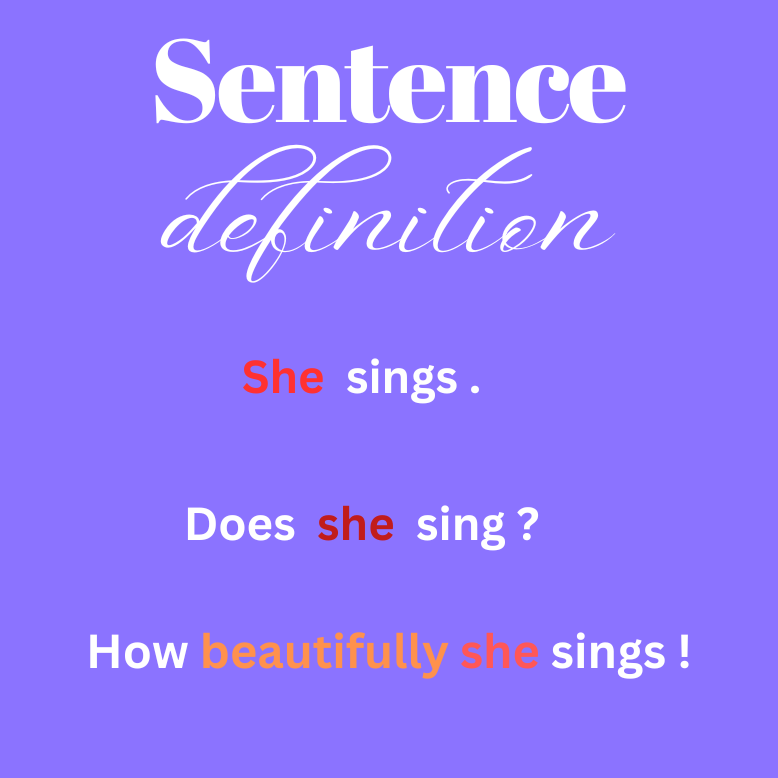What is Sentence? Definition of a Sentence

Definition of a Sentence
A sentence is a grammatical unit in language that typically consists of one or more words organized in a specific order to convey a complete thought, idea, statement, question, command, or exclamation.
Sentences are the basic building blocks of written and spoken communication, and they serve to express meaning and convey information.
A well-formed sentence generally includes the following elements:
Main parts of a Sentence:
Subject: The subject is usually a noun or pronoun that represents the main focus of the sentence, the “doer” of the action, or the entity about which something is being said.
Predicate: The predicate is the part of the sentence that contains the verb and provides information about what the subject is doing or what is happening to it.
For example: in the sentence “She sings beautifully,” “She” is the subject, and “sings beautifully” is the predicate.
The subject tells us who is performing the action (singing), and the predicate provides information about the action itself.
Secondary parts of a Sentence:
The subject and verb are two of the main parts of a sentence, but sentences can contain additional elements beyond just the subject and verb.
Here’s a brief overview of some of these elements:
Object: In many sentences, you’ll find an object, which is a noun or noun phrase that receives the action of the verb.
There are two primary types of objects:
Direct Object: This is the noun or noun phrase that directly receives the action of the verb.
For example: in the sentence “She eats an apple,” “an apple” is the direct object because it receives the action of the verb “eats”.
Indirect Object: An indirect object is a noun or noun phrase that indicates to whom or for whom the action is done.
It often appears with verbs that involve giving or transferring something.
For example: in the sentence “She gave sister a gift,” “her sister” her is the indirect object because it tells us to whom the gift was given.
Attribute (Adjective or Adjectival Phrase): An attribute is an element in a sentence that describes or modifies a noun, providing additional information about it.
It often consists of an adjective or an adjectival phrase.
For example: in the sentence “The tall building stands in the city,” “tall” is an adjective that functions as an attribute, providing information about the noun “building.”
Adverbial Modifiers: Adverbial modifiers provide additional information about the action in the sentence, including details about how, when, where, or to what extent the action is performed.
Adverbial modifiers can be single adverbs or adverbial phrases.
For example: in the sentence “She sings beautifully in the park,” “beautifully” is an adverb that modifies the verb “sings,” and “in the park” is an adverbial phrase that provides information about the location of the action.
Structure of a sentence:
Sentences can vary in structure and complexity. They can be classified into two main categories: simple sentences and complex sentences.
Simple Sentences:
Simple sentences are composed of a single independent clause, which means they express a complete thought or idea on their own.
Simple sentences typically consist of a subject and a verb, but they can also include objects, attributes, and adverbial modifiers.
Examples of simple sentences include:
She sings.
The cat chased the mouse.
He is very talented.
Complex Sentences:
Complex sentences, on the other hand, consist of one or more independent clauses and one or more dependent clauses.
Independent clauses can stand alone as complete sentences, while dependent clauses cannot.
Complex sentences are formed by joining these clauses together to create a more intricate structure.
Examples of complex sentences include:
Although it was raining, she went for a walk.
(The independent clause is “she went for a walk,” and the dependent clause is “Although it was raining.”)
He studied hard because he wanted to pass the exam.
(Two independent clauses, “He studied hard” and “he wanted to pass the exam,” are connected by the subordinating conjunction “because.”)
Complex sentences allow for the expression of relationships between ideas, causes and effects, conditions, and more.
They are often used to convey more nuanced and detailed information.
In addition to simple and complex sentences, there are also compound sentences (which consist of two or more independent clauses joined by coordinating conjunctions like “and,” “but,” “or,” etc.) and compound-complex sentences (which combine elements of both compound and complex sentences).
What are the 4 types of Sentences?
There are indeed four main types of sentences, each serving a different communicative purpose:
Declarative Sentences:
Declarative sentences make statements or convey information.
They are the most common type of sentence and typically end with a period (.)
Examples include:
The sun is shining.
I like to read books.
Interrogative Sentences:
Interrogative sentences are used to ask questions and seek information.
They usually begin with question words (who, what, where, when, why, how) or an auxiliary verb (is, are, can, will, etc.), and they end with a question mark (?).
Examples include:
Where is the nearest supermarket?
Did you enjoy the movie?
Imperative Sentences:
Imperative sentences are used to give commands, make requests, or offer suggestions.
They are typically short and direct, and the subject (you) is often implied but not explicitly stated.
Imperative sentences can end with a period (.) or an exclamation mark (!) for added emphasis. Examples include:
Please pass the salt. (request)
Close the door! (command)
Exclamatory Sentences:
Exclamatory sentences express strong emotions, excitement, surprise, or other intense feelings.
They often begin with words like “how” or “what,” and they end with an exclamation mark (!).
Examples include:
What a beautiful sunset!
How amazing that performance was!
These four types of sentences are fundamental in written and spoken language as they help convey different tones, purposes, and emotions in communication.
What is Sentence? Definition of a Sentence
What is Syntax? Syntax in English
What is a Pronoun? The Functions of the English pronouns.